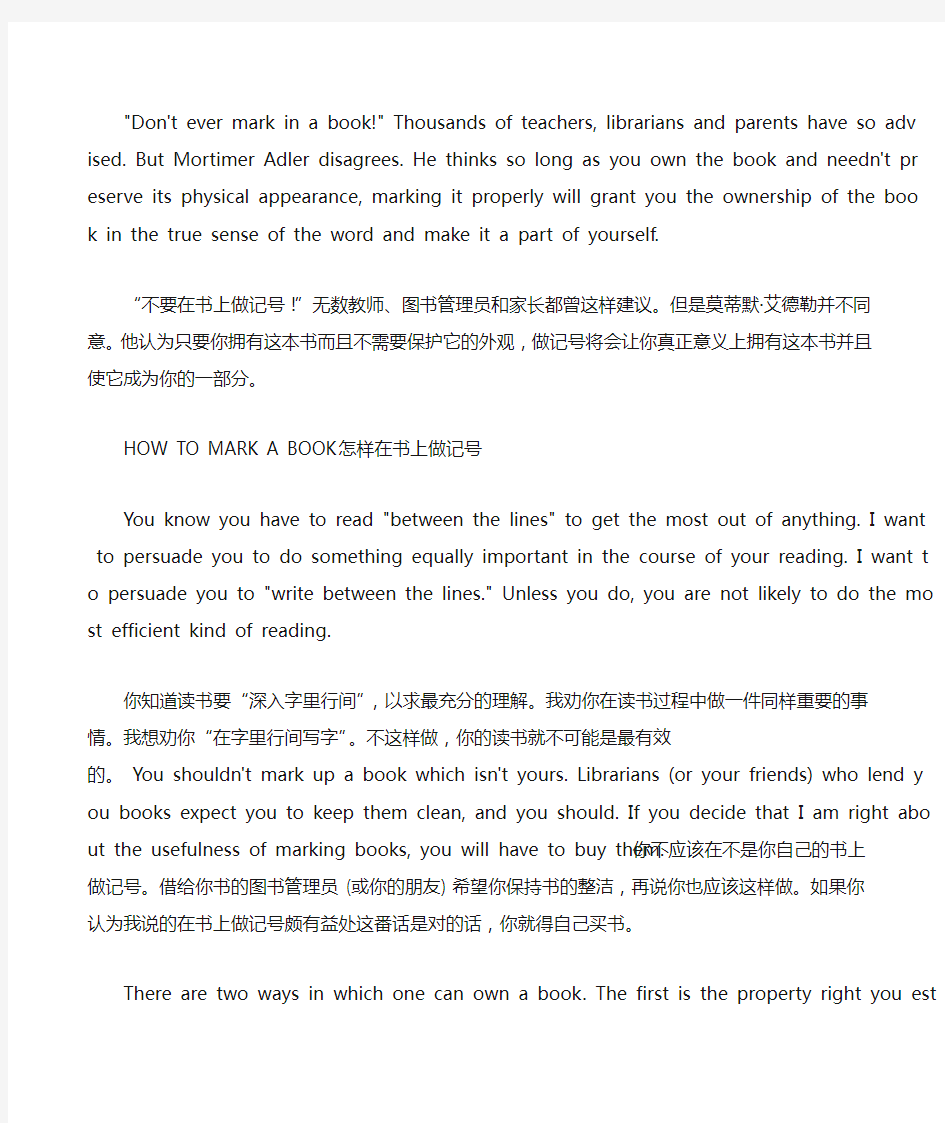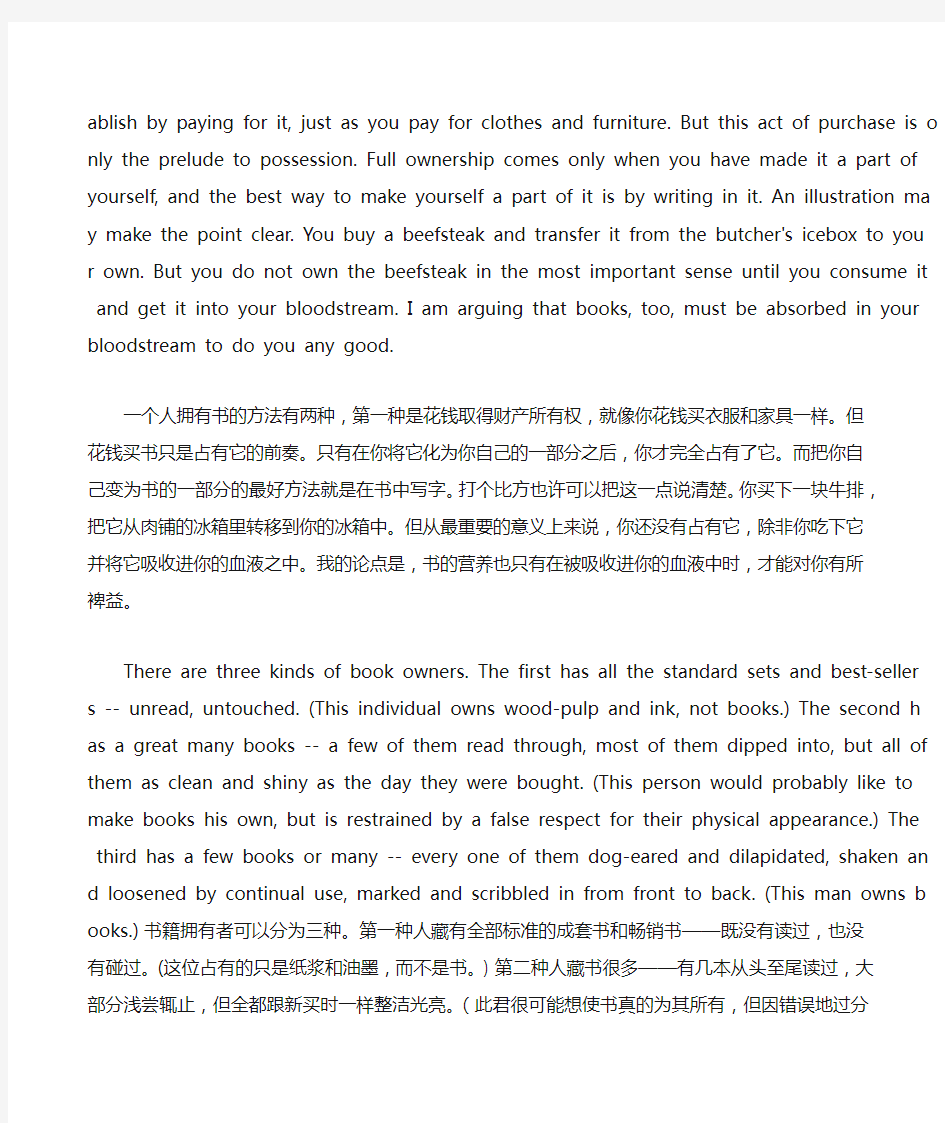How to Mark a Book


"Don't ever mark in a book!" Thousands of teachers, librarians and parents ha ve so advised. But Mortimer Adler disagrees. He thinks so long as you own the book and needn't preserve its physical appearance, marking it properly will gr ant you the ownership of the book in the true sense of the word and make it a part of yourself.
“不要在书上做记号!”无数教师、图书管理员和家长都曾这样建议。但是莫蒂默·艾德勒并不同意。他认为只要你拥有这本书而且不需要保护它的外观,做记号将会让你真正意义上拥有这本书并且使它成为你的一部分。
HOW TO MARK A BOOK怎样在书上做记号
You know you have to read "between the lines" to get the most out of anythin g. I want to persuade you to do something equally important in the course of your reading. I want to persuade you to "write between the lines." Unless you do, you are not likely to do the most efficient kind of reading.
你知道读书要“深入字里行间”,以求最充分的理解。我劝你在读书过程中做一件同样重要的事情。我想劝你“在字里行间写字”。不这样做,你的读书就不可能是最有效
的。 You shouldn't mark up a book which isn't yours. Librarians (or your frien ds) who lend you books expect you to keep them clean, and you should. If you decide that I am right about the usefulness of marking books, you will have to buy them. 你不应该在不是你自己的书上做记号。借给你书的图书管理
员 (或你的朋友) 希望你保持书的整洁,再说你也应该这样做。如果你认为
我说的在书上做记号颇有益处这番话是对的话,你就得自己买书。There are two ways in which one can own a book. The first is the property righ t you establish by paying for it, just as you pay for clothes and furniture. But th is act of purchase is only the prelude to possession. Full ownership comes only when you have made it a part of yourself, and the best way to make yourself a part of it is by writing in it. An illustration may make the point clear. You buy a beefsteak and transfer it from the butcher's icebox to your own. But you do not own the beefsteak in the most important sense until you consume it and g et it into your bloodstream. I am arguing that books, too, must be absorbed in your bloodstream to do you any good.
一个人拥有书的方法有两种,第一种是花钱取得财产所有权,就像你花钱买衣服和家具一样。但花钱买书只是占有它的前奏。只有在你将它化为你自己的一部分之后,你才完全占有了它。而把你自己变为书的一部分的最好方法就是在书中写字。打个比方也许可以把这一点说清楚。你买下一块牛排,把它从肉铺的冰箱里转移到你的冰箱中。但从最重要的意义上来说,你还没有占有它,除非你吃下它并将它吸收进你的血液之中。我的论点是,书的营养也只有在被吸收进你的血液中时,才能对你有所裨益。
There are three kinds of book owners. The first has all the standard sets and b est-sellers -- unread, untouched. (This individual owns wood-pulp and ink, not books.) The second has a great many books -- a few of them read through, mo st of them dipped into, but all of them as clean and shiny as the day they were bought. (This person would probably like to make books his own, but is restra
ined by a false respect for their physical appearance.) The third has a few book s or many -- every one of them dog-eared and dilapidated, shaken and loosen ed by continual use, marked and scribbled in from front to back. (This man ow ns books.) 书籍拥有者可以分为三种。第一种人藏有全部标准的成套书和畅销书——既没有读过,也没有碰过。(这位占有的只是纸浆和油墨,而不是书。) 第二种人藏书很多——有几本从头至尾读过,大部分浅尝辄止,但全都跟新买时一样整洁光亮。(此君很可能想使书真的为其所有,但因错误地过分关注书籍的外观而裹足不前。)第三种人藏书或多或少——因不断使用,每本书都弄成书角卷起,破旧不堪,装订破损,书页松散,全书从扉页至末页画满了记号,涂满了字句。(此人是书的真正拥有
者。) Is it false respect, you may ask, to preserve intact a beautifully printed b ook, an elegantly bound edition? Of course not. I'd no more scribble all over a first edition of "Paradise Lost" than I'd give my baby a set of crayons and an ori ginal Rembrandt! I wouldn't mark up a painting or a statue. Its soul, so to spea k, is inseparable from its body. And the beauty of a rare edition or of a richly manufactured volume is like that of painting or a statue. If your respect for ma gnificent binding or printing gets in the way, buy yourself a cheap edition and pay your respects to the author. 你或许会问,将一本印刷精美、装帧雅致的书保存完好,难道也是不恰当的吗?当然不是。我决不会在一本初版的《失乐园》上乱涂乱写,就像我不会把一幅伦勃朗的原作连同一盒蜡笔交给我的婴孩任意涂抹一样!我决不会在一幅油画或一尊塑像上画记号。可以说,它们的灵魂与其躯体是不可分开的。一部珍本或一本装帧华美的书的美,
同一幅油画或一尊塑像的美是一样的。如果你对华美的装帧或印刷的尊重妨碍你读书,那就买一种便宜的版本,将你的敬意献给作者。
Why is marking up a book indispensable to reading? First, it keeps you awake. (And I don't mean merely conscious; I mean wide awake.) In the second place, reading, if it is active, is thinking, and thinking tends to express itself in words, spoken or written. The marked book is usually the thought-through book. Fin ally, writing helps you remember the thoughts you had, or the thoughts the a uthor expressed. Let me develop these three points. 为什么在书上做记号对阅读是必不可少的呢?首先,它会使你保持清醒。(我不是仅仅指它让你神志清醒;我的意思是它能使你全神贯注。)其次,如果阅读是一种能动的行为,那么它就是思考,而思考常常需借助口头的或书面的语言来表达。作了记号的书,通常是读者认真思考过的书。最后,写可以帮助你记住你阅读时的思想,或作者所表达的思想。让我进一步就这三点谈一谈。
If reading is to accomplish anything more than passing time, it must be active. you can't let your eyes glide across the lines of a book and come up with an u nderstanding of what you have read. Now an ordinary piece of light fiction, lik e, say, "Gone with the Wind," doesn't require the most active kind of reading. The books you read for pleasure can be read in a state of relaxation, and nothi ng is lost. But a great book, rich in ideas and beauty, a book that raises and tri es to answer great fundamental questions, demands the most active reading o f which you are capable. You don't absorb the ideas of John Dewey the way yo u absorb the crooning of Mr. Vallee. You have to reach for them. That you can
not do while you're asleep.
如果阅读的目的不仅仅是消磨时间,那就应该是一种积极的思维活动。仅仅让你的眼睛在书上扫视一遍,你就不可能对所读的内容有所理解。当然,一部普通的消遣小说,譬如说《飘》,并不需要那种最积极的思维式的阅读。作为消遣的书,可以轻松地读而不会有所失。但一本思想丰富、文字华美,试图提出带根本性的重大问题并加以回答的伟大著作,则要求你尽可能地进行最积极的阅读。你不能像欣赏瓦利先生的低声吟唱那样,学到约翰·杜威的思想。你得花费气力方可获得。漫不经心是做不到这一点的。If, when you've finished reading a book, the pages are filled with your notes, y ou know that you read actively. The most famous active reader of great books I know is President Hutchins, of the University of Chicago. He also has the hard est schedule of business activities of any man I know. He invariably read with pencil, and sometimes, when he picks up a book and pencil in the evening, he finds himself, instead of making intelligent notes, drawing what he calls " cavia r factories" on the margins. When that happens, he puts the book down. He k nows he's too tired to read, and he's just wasting time. 如果当你读完一本书的时候,书页上写满了你的批注,你就知道你的阅读是积极的了。我所知道的最有名的采用积极方式阅读伟大著作的人,是芝加哥大学的校长哈钦斯。他也是我所知道的公务最繁忙的人。他读书时总是拿着铅笔。有时,当他在晚上拿起书和铅笔的时候,发觉自己不是在做有意义的笔记,而是在页边空白处画些他称之为“鱼子酱工厂”的东西,一出现这种情况,他就放下书本。他知道自己太累,读不下去了,完全是在浪费时间。
But, you may ask, why is writing necessary? Well, the physical act of writing, w ith your own hand, brings words and sentences more sharply before your min d and preserves them better in your memory. To set down your reaction to im portant words and sentences you have read, and the questions they have rais ed in your mind, is to preserve those reactions and sharpen those questions. Y ou can pick up the book the following week or year, and there are all your poi nts of agreement, disagreement, doubt and inquiry. It's like resuming an interr upted conversation with the advantage of being able to pick up where you left off. 但是,你或许会问,写有何必要呢?要知道,亲手书写的动作会使词语和句子更加鲜明地呈现在你的脑海里,更好地储存在你的记忆中。将你对所读的重要词语和句子的感受写下来,将它们在你脑子里引起的问题记下来,就可以将这些感受长久保存下来,并可以使那些问题更加明确起来。当你下周或来年重新拿起这本书的时候,你的各种观点,同意的、反对的、怀疑的、质询的,统统一目了然。这如同谈话一度被打断,现在又可以在上次停下的地方接着谈下去了。
And that is exactly what reading a book should be: a conversation between yo u and the author. Presumably he knows more about the subject than you do; naturally you'll have the proper humility as you approach him. But don't let an ybody tell you that a reader is supposed to be solely on the receiving end. Und erstanding is a two-way operation; learning doesn't consist in being an empty receptacle. The learner has to question himself and question the teacher. He e ven has to argue with the teacher, once he understands what the teacher is sa
ying. And marking a book is literally an expression of your differences, or agre ements of opinion, with the author. 读书就该这么个读法: 你同作者应进行
对话。很可能作者在有关的问题上比你懂得多,你接近他的时候表示适度的谦恭是很自然的。但不要轻信他人,以为读者只有全盘接受的份儿。理解是一种双向活动。学习并不是往空的容器中装东西。学生应当向自己也向教师提问题。一旦理解了教师所讲的内容,他甚至还得与教师展开争论。而在书上做记号,实际上就是表达你赞同或不赞同作者观点的一种方式。There are all kinds of devices for marking a book intelligently and fruitfully. He re's the way I do it:
在书上做记号,有各种各样好的、行之有效的方法。现将我的做法叙述如下: 1. Underlining: of major points, of important or forceful statements. 1. 在文字下面划线: 划出主要论点及重要的或者有力的论述。
2. Vertical lines at the margin: to emphasize a statement already underlined. 2 . 在页边空白处划竖线: 强调已划线的论述部分。
3. Star, asterisk, or other doo-dad at the margin: to be used sparingly, to emph asize the ten or twenty most important statements in the book. 3. 在页边空
白处画五星或六星记号,或其他小符号: 这种记号宜珍惜着用。可用来强调书中十处或二十处最重要的论述。
4. Numbers in the margin: to indicate the sequence of points the author make s in developing a single argument. 4. 在页边空白处写数字: 标明作者展开一个论据的各点顺序。
5. Number of other pages in the margin: to indicate where else in the book th
e author made points relevant to the point marked; to tie up the ideas in a bo ok, which, though they may be separated by many pages, belong together. 5. 在页边空处写其他页的页码: 标明作者在本书其他地方所写的与本论点有关的论点,也可以通过这一办法将书中虽分散各处,但密切有关的观点联系起来。
6. Circling of key words or phrases. 6. 在关键字眼或短语上画圆圈。
7. Writing in the margin, or at the top or bottom of the page, for the sake of: r ecording questions (and perhaps answers) which a passage raise in your mind; reducing a complicated discussion to a simple statement; recording the seque nce of major points right through the book. I use the end-papers at the back o f the book to make a personal index of the author's points in the order of their appearance. 7. 在页边空白处或上下两端加批注: 其目的是记下某段文章在你脑子里引起的问题 (也许还有答案);简要记下复杂的论述;记录贯串全书的一系列的重要论点。我利用书末的衬页将作者的观点按出现的先后次序编成一个索引。
The front end-papers are, to me, the most important. Some people reserve th em for a fancy bookplate, I reserve them for fancy thinking. After I have finish ed reading the book and making my personal index on the back end-papers, I turn to the front and try to outline the book, not page by page, or point by poi nt (I've already done that at the back), but as an integrated structure, with a b asic unity and an order of parts. This outline is, to me, the measure of my und erstanding of the work. 书前的衬页对我来说是最重要的。有些人将它们留
作贴花哨的藏书票用。我将它们留作奇思异想的天地。在我读完一本书并在卷尾衬页上做好我的个人索引之后,我便翻到卷首,试着将全书作一概述,不是逐页地或逐点地进行(那个我在卷尾已经做了),而是作为一个整体,基本上前后连贯,各部分排列有序。对我来说,这个概述表明了我对该著作理解的程度。
https://https://www.sodocs.net/doc/ac9634761.html,/view/f3b4dde0cc17552706220835.html
